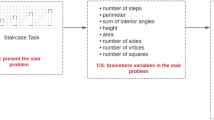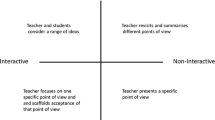Abstract
There is a disconnect between what most curricular documents suggest about connecting classroom pedagogy with learners’ language and everyday context, and what the language of mathematics textbooks and the language of mathematics classroom practices present. Attempting to bridge this gap is often a design challenge for classroom teaching practices that face multiple languages during mathematics learning processes. In this paper I discuss results from a teaching design experiment for fostering meaning, using language support, in a middle grades mathematics classroom. I analyse the complexities and challenges that arise, as a way forward for purposefully relating with teaching practice. Following the design principles of connecting students’ language varieties and engaging them in rich discourse practices during lessons, in this paper I show that enabling shifts in classroom norms by moving from oral to written mathematics, and moving from private to public and shared expressions, fostered meaning making and empowered students’ mathematical communication. Data are drawn from an empirical study conducted in a low-income community engaged in micro-enterprises dispersed among households in India. Children in the community have access to the work-contexts and hence to the mathematical knowledge and language repertoires embedded in them.




Similar content being viewed by others
References
Adler, J. (2001). Teaching mathematics in multilingual classrooms. Kluwer.
Bakker, A. (2018). Design research in education: A practical guide for early career researchers. Routledge.
Banerjee, R. (2008). Developing a learning sequence for transiting from arithmetic to elementary algebra. Unpublished PhD dissertation. Homi Bhabha Centre for Science Education, TIFR.
Barwell, R., Clarkson, P., Halai, A., Kazima, M., Moschkovich, J., Planas, N., Phakeng, M., Valero, P., & Villavicencio-Ubillús, M. (2016). Mathematics education and language diversity: The 21st ICMI Study. Springer.
Basu, D. D. (2008). Introduction to the Constitution of India. (1st Edition: 1960). LexisNexis Butterworths Wadhwa.
Bose, A. (2015). Work, knowledge and identity: Implications for school learning of out-of-school mathematical knowledge. Unpublished PhD dissertation. Homi Bhabha Centre for Science Education, TIFR.
Bose, A., & Choudhury, M. (2010). Language negotiation in a multilingual mathematics classroom: An Analysis. In L. Sparrow, B. Kissane, & C. Hurst (Eds.), Shaping the future of mathematics education, Proceedings of the 33rd Conference of the Mathematics Education Research Group of Australasia (pp. 93–100). Fremantle, Australia: MERGA.
Bose, A., & Clarkson, P. (2016). Students' use of their languages and registers: An example of the socio-cultural role of language in multilingual classrooms. In A. Halai & P. Clarkson (Eds.), Teaching and learning mathematics in multilingual classrooms: Issues for policy and practice (pp. 125–141).). Rotterdam, The Netherlands: Sense Publishers.
Bose, A., & Kantha, V. K. (2014). Influence of socio-economic background and cultural practices on mathematics education in India: A contemporary overview in historical perspective. ZDM Mathematics Education, 46(7), 1073–1084.
Bose, A. & Phakeng, M. (2017). Language practices in multilingual mathematics classrooms: Lessons from India and South Africa. In B. Kaur, W.K. Ho, T.L. Toh, & B.H. Choy (Eds.). Proceedings of the 41st Conference of the International Group for the Psychology of Mathematics Education (Vol. 2, pp. 177–184). PME.
Bose, A. & Subramaniam, K. (2013). Characterising work-contexts from a mathematics learning perspective. In Nagarjuna, G., A. Jamakhandi & E. M. Sam (Eds.). Proceedings of epiSTEME-5: International conference to review research on Science, Technology and Mathematics Education (pp. 173–179). CinnamonTeal Publishing.
Campana, J. (Ed.). (2013). DHARAVI: The city within . HarperCollins Publishers India.
Chakraborty, J. (1893/1952). Patiganit. P C Chakraborty & Brothers
Clarkson, P. C. (2007). Australian Vietnamese students learning mathematics: High ability bilinguals and their use of their languages. Educational Studies in Mathematics, 64(2), 191–215.
Cobb, P., Confrey, J., diSessa, A., Lehrer, R., & Schauble, L. (2003). Design experiments in educational research. Educational Researcher, 32(9), 9–13.
Cobb, P., & Steffe, L. P. (1983). The constructivist researcher as teacher and model builder. Journal for Research in Mathematics Education, 14(2), 83–95.
Cobb, P., & Whitenack, J. W. (1996). A method for conducting longitudinal analyses of classroom video recordings and transcripts. Educational Studies in Mathematics, 30(3), 213–228.
Cohen, L., Manion, L., & Morrison, K. (2013). Research methods in education. Routledge.
Erath, K., Ingram, J., Moschkovich, J., Prediger, S.(2021). Designing and enacting instruction that enhances language for mathematics learning: a review of the state of development and research. ZDM - Mathematics Education, 53(2).
González, N. (2005). Beyond culture: The hybridity of funds of knowledge. In N. González, L. C. Moll, & C. Amanti (Eds.), Funds of knowledge: Theorizing practices in households, communities, and classrooms (pp. 29–46). Lawrence Erlbaum.
Gravemeijer, K. (2016). Design-research-based curriculum innovation. Quadrante, XXV(2), 7–23.
Gravemeijer, K. & Prediger, S. (2019). Topic specific design research: An introduction. In G. Kaiser & N. Presmeg (Eds.). Compendium for early career researchers in mathematics education (pp. 33–57). ICME-13 Monograph. Springer Open.
Herbel-Eisenmann, B., Choppin, J., Wagner, D., & Pimm, D. (2011). Equity in discourse for mathematics education. Springer.
Ministry of Home Affairs, Government of India (2016). http://mha.nic.in/hindi/sites/upload_files/mhahindi/files/pdf/Eighth_Schedule.pdf Accessed 30 May 2016 1700SAST.
Moschkovich, J. (2010). Recommendations for research on language and mathematics education. In J. Moschkovich (Ed.), Language and mathematics education (pp. 1–28). Information Age.
National Council of Educational Research and Training [NCERT]. (2005). The national curriculum framework. NCERT.
National Council of Educational Research and Training [NCERT]. (2006). Position Paper of National Focus Group on Teaching of Mathematics. NCERT.
Phakeng, M. S. (2016). Mathematics education and language diversity: Mathematics education and language diversity. In A. Halai & P. Clarkson (Eds.), Teaching and learning mathematics in multilingual classrooms (pp. 11–23). Sense Publishers.
Phakeng, M., Planas, N., Bose, A. & Nujurai, E. (2018). Teaching and learning mathematics in trilingual classrooms: Learning from three different continents. In R. Hunter, M. Civil, B. Herbel-Eisenmann, D. Wagner & N. Planas (Eds.). Mathematical discourse that breaks barriers and creates space for marginalized learners (pp. 277–304). Sense Publishers.
Planas, N., & Setati-Phakeng, M. (2014). On the process of gaining language as a resource in mathematics education. ZDM Mathematics Education, 46(6), 883–893.
Prediger, S., Gravemeijer, K., & Confrey, J. (2015). Design research with a focus on learning processes: An overview on achievements and challenges. ZDM Mathematics Education, 47, 877–891.
Prediger, S., Schnell, S., & Rösike, K. A. (2016). Design research with a focus on content-specific professionalization processes: The case of noticing students’ potentials. In Proceedings of the third ERME topic conference on mathematics teaching, resources and teacher professional development (pp. 96–105).
Prediger, S., & Schüler-Meyer, A. (2017). Fostering the mathematics learning of language learners: Introduction to trends and issues in research and professional development. EURASIA Journal of Mathematics, Science and Technology Education, 13(7b), 4049–4056.
Prediger, S., Wilhelm, N., Büchter, A., Gürsoy, E., & Benholz, C. (2018). Language proficiency and mathematics achievement. Journal für Mathematik-Didaktik, 39(1), 1–26.
Ruiz, R. (1984). Orientations in language planning. NABE Journal, 8(2), 15–34.
Setati, M., & Adler, J. (2001). Between languages and discourses: Language practices in primary multilingual mathematics classrooms in South Africa. Educational Studies in Mathematics, 43(3), 243–269.
Shavelson, R. J., Phillips, D. C., Towne, L., & Feuer, M. J. (2003). On the science of education design studies. Educational researcher, 32(1), 25–28.
Subramaniam, K. & Bose, A. (2012). Measurement units and modes: The Indian context. In Proceedings of the 12th International Congress on Mathematical Education (ICME-12), (pp. 1974–1983). ICME.
Thirumalai, B., Ramanathan, A., Charania, A., & Stump, G. (2019). Designing for technology-enabled reflective practice: Teachers’ voices on participating in a connected learning practice. In R. Shetty, R. Iyengar, M. A. Witenstein, E. J. Byker, & H. Kidwai (Eds.), Teaching and teacher education: South Asian perspectives (pp. 243–272). Palgrave Macmillan.
Treffers, A. (1987). Three dimensions: A model of goal and theory description in mathematics instruction—The Wiskobas project. Kluwer Academic Publishers.
Webb, D. C., van der Kooij, H., & Geist, M. R. (2011). Design research in The Netherlands: Introducing logarithms using realistic mathematics education. Journal of Mathematics Education at Teachers College, 2(1), 47–52.
Acknowledgements
I would like to thank my mentor and colleague K. Subramaniam for the enriching discussions, guidance and suggestions with the ideas formulated in this text and Norma Presmeg for the valuable editorial comments.
Author information
Authors and Affiliations
Corresponding author
Additional information
Publisher's Note
Springer Nature remains neutral with regard to jurisdictional claims in published maps and institutional affiliations.
Rights and permissions
About this article
Cite this article
Bose, A. Fostering meaning in a trilingual mathematics classroom by connecting everyday and school mathematical ways of talking: a design approach. ZDM Mathematics Education 53, 405–417 (2021). https://doi.org/10.1007/s11858-021-01254-1
Accepted:
Published:
Issue Date:
DOI: https://doi.org/10.1007/s11858-021-01254-1




